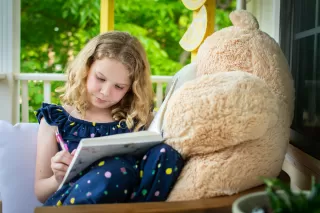Where Does Creativity Reside in the Brain?
When I was a kid, I spent hours writing. My sister and I shared a small walk-in closet, and while she used her half for organizing her up-to-the-minute fashions on rolling clothes racks and stacked cardboard drawers, I used my half of the space to write stories, poems, and even a stapled-together illustrated superhero book. I painted the walls with bright magic marker flowers and worked by flashlight in my little writing cave.
My parents encouraged my interest in writing. I had some poetry published in the local newspaper and in a book called Poetry Parade. (I was their youngest poet at the time; I don’t think they had a very selective process.) My third-grade teacher was also a support. Every month, she let me write one of my poems on the side chalkboard and illustrate it as well.
But somewhere along the line, I started getting A’s in math and science, and people became less encouraging of my artwork and writing. Eventually, my grades became more important to me than a poem on a chalkboard. I learned to do what I was good at, not what I was naturally drawn to.
Make Room for Creativity
Though I eventually came back to writing as my primary vocation, it was only after 30 years in medicine. What I learned from all that time away from my first love is that it is up to us to keep creativity alive in our day-to-day. We must make room for it. Be open to it. Tend it with care. No one is going to hand us that precious hour to create or show us the way to the art table. We must take those steps ourselves.
The Creativity Circuit
As a doctor, I’ve always wondered about the biological underpinnings of creativity. What is it? Where does it come from? How can we sustain and nurture it? We know that the brain is heavily involved in the creative process because certain brain diseases or injuries affect creative output, either decreasing it or paradoxically increasing it.
Scientists have learned from functional MRI or brain-mapping studies that different creative tasks map to different brain regions. But in an article published last month in the Journal of the American Medical Association, a group of researchers led by a scientist at Brigham and Women’s Hospital in Boston asked a different question. They wondered, if there is such a thing as a creativity map of the brain, might it be more fruitful to look for creativity networks or connections rather than distinct brain regions associated with creativity itself?
As it turns out, this was the right question to ask. Using this network approach, researchers localized creativity to a common brain circuit across different creative domains, including music, drawing, and writing. These findings suggest that, even if the brain region utilized for music-making is different from the region associated with writing, there is a common neural substrate that connects these disparate creative tasks.
What regions exactly are being connected by this shared circuitry, and what might it mean for us creatives? Well, in the distinct brain regions identified as being activated during writing, music-making, and creating art, those activated areas of the brain were connected by this creativity circuit to the right frontal pole of the brain, which was actually deactivated.
Now this finding may simply mean that these researchers have identified an area of the brain central to the creative process, the right frontal pole. It is also possible that this brain region is deactivated as a means of dampening a more analytical brain region during the early idea-generating steps in the creative process. Perhaps this is analogous to us having to actively shut off our internal critic or inner editors when we are freewriting first drafts in order to get our ideas on the page before letting that critic or editor back in later in the creative process.
The Search for Creativity
My brother-in-law is an acupuncturist. Whenever he comes to visit, I ask him for a “Thousand Meeting Places” treatment. (He always has his needles with him.) The name Thousand Meeting Places refers to the point at the crown of the head where several meridians or pathways converge. The treatment can be used for many ailments, from sinus pain to sleep disorders. It is also used to increase creativity. As the needle slides into my scalp, I sit quietly, breathe deeply, and let my creative qi (chi) become unblocked.
I don’t think there are any randomized controlled studies affirming the validity of the Thousand Meeting Places technique for enhancing creative output. A number of my artist friends swear by it. I don’t necessarily think the newly discovered “creativity circuit” will be the key to our collective search for our creative lodestone either, pointing us to our creative due north. We still don’t have a clear map we can follow when creating art or literature. We do know that engaging in creative work every day enhances our sense of well-being. So, I will keep looking for answers to how we create, why we create, and what our creativity means in our everyday lives.



